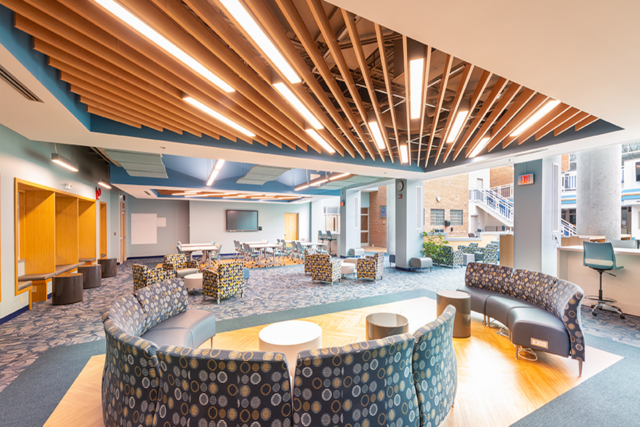Illuminate With Impunity

LED light fixtures have evolved to become the first choice of designers, end-users, facilities staff, and energy codes. Today’s fixtures reduce costs and achieve better student outcomes.
As LED fixtures have become the industry standard in almost all applications of general lighting, it wasn’t that long ago that fluorescent tubes were the go-to source for lighting in K-12 schools. In both new construction and renovation work, LED fixtures are now preferred for myriad reasons.
LED lighting faced many challenges early on. The color temperature was inconsistent between fixtures, with too-blue or too-pink hues common. As manufacturers rushed to enter the LED market, early fixtures were simply fluorescent fixtures that were retrofitted for LEDs. There were few, if any, industry standards, so it was next to impossible to compare fixtures and evaluate equals. Thankfully, technology and industry standards have improved greatly in the last 10-15 years, and resulted in fixtures perfectly suited to the K-12 environment.
LEDs came to market with the promise of unparalleled energy efficiency, and delivered. Since then, the focus on improved usability and function has created customization features that directly impact the learning environment.
LED troffers offer a variety of post-installation adjustments, for characteristics like color temperature (warmer/cooler) or brightness (lumen output). Features such as Dynamic White Lighting can have the lights dim to warm, simulating incandescent light, or can be programmed to change the color temperature to simulate daylight. Why is color temperature so important? Studies have revealed the importance of circadian rhythms in teenage students, meaning the ability to create “daylight” in classrooms can improve learning outcomes. Other studies have revealed that cooler color temperatures may help students with hyperactivity.
Controls have become a major focus of both designers and of energy codes. Fixtures can be fitted with drivers that can communicate wirelessly with a room control panel. The same panel can be integrated with the room dimmer switch, occupancy/vacancy sensors, and daylight sensors in a classroom to maximize energy savings. Easy to use, advanced controls allow educators to customize their classroom lighting to better support their instruction and provide a truly flexible classroom setup. Giving instructors better lighting control also makes for more inclusive classrooms for students with sensory issues, and reduces eye strain for all.
In large facilities like K-12 schools, LEDs long life span greatly reduces maintenance costs. Facilities teams no longer have to replace bulbs in hard to reach fixtures, such as in auditoriums and gymnasiums, and reduce storage needs for replacement lamps. High-abuse environments benefit from the durability of LED fixtures, retiring the risk of fluorescent lamps shattering.
All of these features come at a reasonable price tag; some manufacturers are estimating the payback period for most educational facilities can be as little as one to three years. When it comes to size, style, and shape, LED fixtures are also unmatched, allowing your design team to create spaces that inspire.